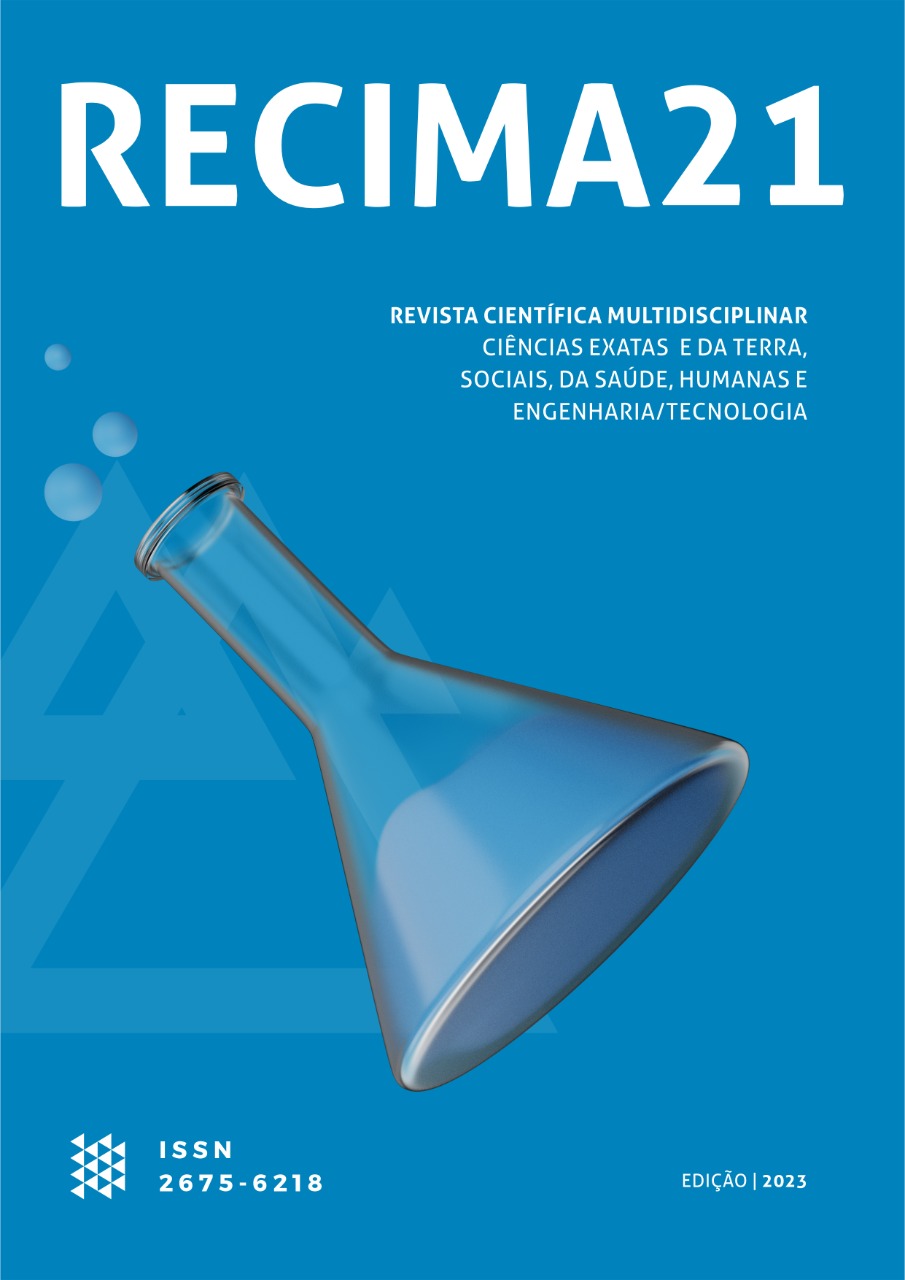STUDY ON LEISHMANIASIS IN THE MUNICIPALITY OF CARLOS CHAGAS (MG) AND THE MAIN CONSEQUENCES OF ITS CONTAMINATION IN THE ANIMAL POPULATION
DOI:
https://doi.org/10.47820/recima21.v4i11.4504Keywords:
Visceral Leishmaniasis, Public Health, epidemiologyAbstract
This article addressed the topic of canine visceral leishmaniasis (CVL), a parasitic and endemic disease that can be fatal for some animals and people. It is generated by Leishmania Chagasi, transmitted through the blood meal of an insect called sand flies (Lutzomvia longipalpis), popularly known as straw mosquitoes. The disease has taken on enormous proportions in Brazil, being considered a public health disease. In addition to the literature review, field research with a quantitative approach was carried out. The study aimed to analyze the leishmaniasis rate in Carlos Chagas - MG, presenting how the municipality has dealt with this endemic, highlighting quantitative data on leishmaniasis cases with a focus on the aforementioned municipality. The research was carried out by the Endemic Disease Control Sector. The results indicate that there was growth over the years mentioned in the research, in addition to other observations present in the study. It was observed that in 2021, the animals reacting to the DPP® test were 32.42%, in 2022, they were 39.74%. However, in 2023 there was a decline, presenting a percentage of 27.95%, the tests carried out as controls show the same decline as the reagent tests in 2023. For this reason, it is understood that in all the statistical data presented in the study, the percentages are minimal compared to other years. The importance of prevention is noted, with the full involvement of public health, highlighting the direct participation of the veterinarian, essential in all processes involving the disease, from diagnosis to prevention.
Downloads
References
ALBUQUERQUE, A. L. H.; LANGONI, H. A prática do tratamento na Leishmaniose visceral canina (LVC) em clínicas veterinárias, cuidados e protocolos. Vet. E Zootec., v. 25, n. 1, p. 132-141, jun. 2018.
ALVAR, J.; MOLINA, R.; SAN ANDRÉS, M.; TESOURO, M.; NIETO, J.; VITUTIA, M.; GONZÁLEZ, F.; SAN ANDRÉS, M.D.; BOGGIO, J.; RODRIGUEZ, F.; SÁINZ, A.; ESCACENA, C. Canine leishmaniasis: clinical, parasitological anda entomological follow-up after chemotherapy. Annals of Tropical Medicine and Parasitology, v. 88, p. 371- 378, 1994.
BADARÓ, R.; REED, S. G.; CARVALHO, E. M. Immunofluorescent antibody test in American visceral leishmaniasis: sensitivity and specificity of different morphological forms of two Leishmania species. The American Journal of Tropical Medicine and Hygiene, v. 32, n. 3, p. 480-84, 1983.
BRASIL. Leishmaniose Visceral. Brasília: Ministério da Saúde. Gabinete do Ministro, 2020.
BRASIL. Ministério da Saúde. Manual de vigilância e controle da Leishmaniose Visceral: normas e manuais técnicos. Brasília: Ministério da Saúde, 2003. 120p.
BRASIL. Nota Técnica n. 023/CPV/ DFIP/SDA/MAPA - publicada em 19 de setembro de 2008. Brasilia: Ministério da Agricultura, Pecuária e Abastecimento, 2008. Disponível em: http://www.sbmt.org.br/portal/wpcontent/uploads/2016/09/nota-tecnica.pdf.
BRASIL. Portaria Interministerial n. 1.426, de 11 de julho de 2008. Brasilia: Ministério da Saúde, 2008. Disponível em: http://bvsms.saude.gov.br/bvs/saudelegis/gm/2008/pri1426_11_07_2008.html.
CONSELHO FEDERAL DE MEDICINA VETERINARIA. Leishmaniose Visceral Canina. Brasília: CFMV, 15 maio 2021. Disponível em: https://www.cfmv.gov.br/perguntas-e-respostas-sobre-a-leishmaniose-visceral-canina-lvc-questoes-tecnicas-e-legais/transparencia/perguntas-frequentes/2018/10/26/. Acesso em: 31 out. 2023.
CONSELHO FEDERAL DE MEDICINA VETERINÁRIA. Resolução n. 1000 de 11 de maio de 2012, que dispõe sobre procedimentos para eutanásia de animais [Internet]. Brasília: CFMV, 2012 Disponível em: http://portal.cfmv.gov.br/lei/index/id/326.
FUNDAÇÃO OSWALDO CRUZ. Leishmaniose: Agência Fiocruz de Notícias. Rio de Janeiro: Fiocruz, 2013.
INIESTA, L. et al. Diagnostic techniques to detect cryptic leishmaniasis in dogs. Clinical and Diagnostic Laboratory Immunology, v. 9, n. 5, p. 1137-1141, 2002.
LOPES, Valquriria; VALE, João Henrique. Leishmaniose volta a crescer em Minas Gerais e já matou mais que dengue. Estado de Minas, 19 set. 2017.
MERGEN, Maria Eduarda; SOUZA, Marília Mascarenhas. Leishmaniose Visceral canina, métodos diagnósticos e tratamento na atualidade. Revisão de literatura. Revista JRG de Estudos Acadêmicos, v. 6, n. 13, p. 1024-1036, 2023.
MINISTÉRIO DA SAÚDE. Guia de Vigilância em Saúde: Volume 3. Brasília/DF: Ministério da Saúde, 2017.
SILVA, F. S. Patologia e patogênese da leishmaniose visceral canina. Revista Trópica – Ciências Agrárias e Biológica, v. 1, n. 1, p. 20, 2007.
SILVA, S. R. (Org.) Avaliação da infecciosidade em cães vacinados com Leish-Tec® (Hertape Saúde Animal S/A) para Lutzomyia longipalpis (Diptera: Psychodidae, Phlebotominae). Belo Horizonte: [s. n.], 2015.
TIZARD, I. R. Imunologia Veterinária: introdução. São Paulo: Editora Roca, 2014.
ZANINI, M.; VIEIRA ALMEIDA, Y.; SAVERGNINI POLEZE, L.; ISABELLE SILVA SOUZA, L. Avaliação sorológica de cães vacinados com vacinas comerciais contra leishmaniose visceral no município de Íuna-ES após um ano de vacinação. Pubvet, [S. l.], v. 13, n. 06, 2019. DOI: 10.31533/pubvet.v13n4a352.1-5. Acesso em: 12 nov. 2023.
Downloads
Published
How to Cite
License
Copyright (c) 2023 RECIMA21 - Revista Científica Multidisciplinar - ISSN 2675-6218

This work is licensed under a Creative Commons Attribution 4.0 International License.
Os direitos autorais dos artigos/resenhas/TCCs publicados pertecem à revista RECIMA21, e seguem o padrão Creative Commons (CC BY 4.0), permitindo a cópia ou reprodução, desde que cite a fonte e respeite os direitos dos autores e contenham menção aos mesmos nos créditos. Toda e qualquer obra publicada na revista, seu conteúdo é de responsabilidade dos autores, cabendo a RECIMA21 apenas ser o veículo de divulgação, seguindo os padrões nacionais e internacionais de publicação.













